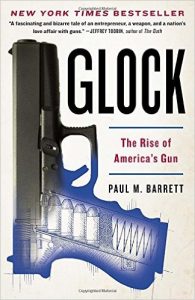 “Glock” is that rarest of beasts—a mainstream writing in which the author makes zero errors about guns, and takes almost no political positions with respect to guns. This is the most neutral book on the topic I have ever seen, which is surprising given that the author, Paul Barrett, worked and works for the violently and maliciously anti-gun Michael Bloomberg. It is not true, as several other reviewers claim, that “Glock” is pro-gun control. It is a history book, not a book of politics, or, for that matter, a technical book on Glock handguns.
“Glock” is that rarest of beasts—a mainstream writing in which the author makes zero errors about guns, and takes almost no political positions with respect to guns. This is the most neutral book on the topic I have ever seen, which is surprising given that the author, Paul Barrett, worked and works for the violently and maliciously anti-gun Michael Bloomberg. It is not true, as several other reviewers claim, that “Glock” is pro-gun control. It is a history book, not a book of politics, or, for that matter, a technical book on Glock handguns.
The book is a straight chronological history interwoven with personality profiles of all the leading players. The one personality looming over everything, of course, is Gaston Glock—sometime machinist of car radiators, door hardware, and knives. The latter led to contacts with the Austrian Ministry of Defense, and when the Austrian military began searching for a new handgun, Glock designed a revolutionary gun from the ground up. The rest, as they say, is history—and a history well covered by this book.
“Glock” is suitable for pretty much any reader. If you want a basic primer on handgun manufacture and use, this is your book. If you want a cultural history of handgun sales and marketing in America in the past three decades, this is your book. If you want an accurate view on the competing political views of gun control proponents and defenders of gun rights, this is your book. And if you just want an interesting story with interesting (and mostly flawed) characters, this is also your book.
Very, very occasionally Barrett (whose name, ironically, is the same as the main brand of .50 caliber, that is, very powerful, rifles sold today) slips in his understanding. “Why, gun-control advocates ask, do civilians need a variant of the military rifles carried by American troops? The answer relates to aesthetics and psychology.” Maybe it does, but more directly, it relates to the reason that the Second Amendment exists—so that citizens can, if necessary, fight American troops in a possible future tyranny with weapons that give them a chance in skirmish warfare and the ability to acquire heavier weapons. Barrett doesn’t grasp this. For the same reason, he sees no reason not to limit magazine capacity, ignoring both the military necessity of large magazines and that even in civilian (police and citizen) armed self-defense large capacity magazines have frequently proven necessary. But he does grasp, for the correct technical and practical reasons, the silliness of modern arguments over so-called “assault weapons.” And these slips are few and far between; they do not detract from the book.
In 2013, when this book was published, Barrett saw correctly that the Left had “abandoned gun control.” Like the dog returning to his vomit, the Left has since latched onto gun control again. As they say, gun control is like crack to Democrats—they know it’s bad for them, but they can’t help themselves. We’ll see how that plays out in two months, in November 2016. But whatever the future holds for gun grabbers, this book will stand for a long time as a readable, fair, and interesting summary exposition of the modern American handgun industry and culture.
